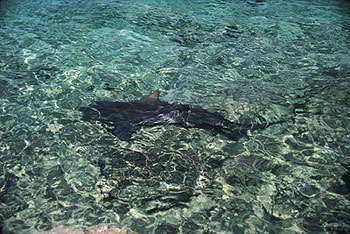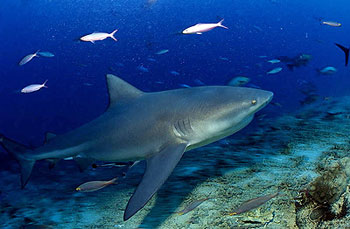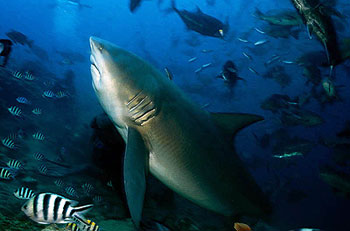
Photo by Klaus Jost
Worldwide, there are only 75 known instances of unprovoked bull shark attacks and 23 human fatalities on record in the International Shark Attack File, a global database housed at the Florida Museum of Natural History. But because so little is known about bull shark, scientists are not able to predict the seasons or ocean areas the sharks are likely to be most active, and therefore, which areas humans should avoid to prevent attacks.
But the Museum’s Florida Program for Shark Research director, George Burgess, is trying to change this. Burgess is initiating a research project using underwater listening devices in Florida’s Indian River Lagoon to gather critical life-history details about bull sharks, rays and skates. Burgess hopes to determine the habitat these creatures need not only to survive, but thrive into the future.
“We want to have enough data to give us predictive powers so we can make recommendations to authorities – whether it’s the Coast Guard or the Navy or beach lifeguards – as to when bull sharks will be most active, most numerous and in what parts of the ocean,” Burgess said.
Burgess said that because bull sharks prefer coastal and near-shore habitats, their populations are more vulnerable to decline by over fishing. Unfortunately, bull sharks can be caught accidentally on commercial long lines, and they may die or receive fatal injuries before they can be released.
In general, very little is known about bull shark life cycles. Scientists know they feed on a variety of ray-finned fishes as well as other elasmobranchs, tolerate a range of salinities, and range throughout the Gulf of Mexico and off Florida’s Atlantic Coast as far north as Virginia. They are also found in waters off of Central America, Brazil and South Africa. They seem to prefer brackish water, but have been known to swim far upstream freshwater rivers. Most impressively, a bull shark was recorded 2,162 miles from the Atlantic in a Peruvian river, and in another instance a bull shark swam 1,740 miles up the Mississippi River and was recorded near Alton, Ill.

Photo by Klaus Jost
While bull shark nursery areas in the Gulf of Mexico have been studied, Atlantic nurseries are comparatively understudied. A former University of Florida graduate student, Tobey Curtis, worked with Burgess and focused his thesis on increasing the limited body of research known about Atlantic bull shark nursery habitat.
“When you start to overlay the recorded shark movements with habitat maps, you start to see which areas are necessary or critical for conservation,” Burgess said.
Curtis’ study showed the Indian River Lagoon is a bull shark nursery. Curtis also found that young bull sharks use the lagoon until they are about 9 years old, and then move into adult habitat offshore. They also appear to leave the lagoon during winter months, and though Curtis was unsure where they went, he suspected the exodus was triggered when water temperatures dipped below 68 degrees.
“We later found the sharks concentrated, along with manatees and sea turtles, around the hot water discharge canals of various power plants,” Burgess said. “So the importance of those discharge areas is pretty marked.”
Curtis also recorded the bull sharks foraging in shallow sea grass beds and sandy habitats, and found evidence that young bull sharks were drawn to low salinity areas, where they tended to be most active. Curtis’ study recommended that several areas within the Indian River Lagoon system be considered a high priority for conservation, including the southern portion of Mosquito Lagoon, Eau Gallie, Crane and Turkey creeks and their adjacent shorelines, and Sebastian Inlet. These areas had the highest catch rates and represented important areas for birthing, foraging and providing refuge.
Although Curtis’ graduate work has ended, other Florida Museum researchers are resuming bull shark tagging and tracking studies to collect data on bull shark life cycles in the Indian River Lagoon.
Bluntnose, Smooth Butterfly, Cownose and Spotted Eagle Rays
Like bull sharks, rays in the Indian River Lagoon have been the focus of Florida Museum tagging and tracking studies in 2006 and 2007 to better understand their life cycles and how they use the lagoon’s habitat. Some scientists believe the rays form an important component of the lagoon’s ecosystem. The species have been recorded there in abundance, but not enough is known about where they breed and give birth, whether they migrate seasonally and to where, what their environmental preferences are and how they use habitat or form home ranges.

Photo by Klaus Jost
To learn more, former Florida Museum postdoctoral researcher Christina Conrath began a tagging study using active and passive tracking similar to Curtis’ bull shark study that concentrated on Mosquito Lagoon. Scientists attached acoustic tags to about 40 rays from four species captured in the lagoon: bluntnose, smooth butterfly, spotted eagle and cownose rays. For 18 months, the tagged rays’ movements were tracked and recorded when they came within range of the underwater listening devices. This provides researchers a seasonal picture of how rays use the lagoon, and helps pinpoint when the animals move in and out of the lagoon. Because cownose and eagle rays are pelagic, meaning they swim in the water column, and bluntnose and butterfly rays are benthic, meaning they dwell on the lagoon bottom, the movements of these species can be compared and researchers can learn how the rays share resources in the lagoon.
Conrath left the Florida Museum to pursue research with the National Marine Fisheries Service and Museum researcher Jason Romine is continuing both the ray and bull shark projects.
Romine said while the ray project sheds light on seasonal movements and home range sizes, he anticipates that the bull shark study will give more detailed data on how younger sharks seek and use certain habitats as refuges. Areas along the Banana River and near warm-water discharge outlets from power plants could be important habitat for younger sharks, he said.
“Exploring their use of these areas will provide us with important habitat information that may support protection of the lagoon environment from further development, which is key to the survival of the critters that inhabit the Indian River Lagoon,” Romine said.
Funding for the bull shark and ray studies was provided by the National Marine Fisheries Service’s Highly Migratory Species Division through the National Shark Research Consortium and the Disney Wildlife Conservation Fund. Additional funding for the ray study was provided by the Florida Fish and Wildlife Conservation Commission.
Learn more about the Ichthyology Collection at the Florida Museum.